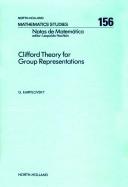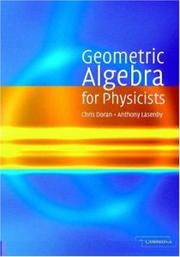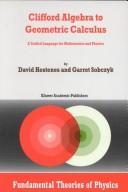| Listing 1 - 10 of 32 | << page >> |
Sort by
|
Periodical
ISSN: 01887009 16614909 Publisher: México, D.F., México : Facultad de Estudios Superiores Cuautitlán, Universidad Nacional Autónoma de México,
Abstract | Keywords | Export | Availability | Bookmark
 Loading...
Loading...Choose an application
- Reference Manager
- EndNote
- RefWorks (Direct export to RefWorks)
Clifford algebras --- Clifford algebras. --- Algèbre de Clifford. --- Mathematical Sciences --- Algebra --- Applied Mathematics --- Àlgebres de Clifford --- Àlgebres de Clifford.
Book
ISBN: 1281378569 9786611378561 3764386061 Year: 2008 Publisher: Basel ; Boston : Birkhauser,
Abstract | Keywords | Export | Availability | Bookmark
 Loading...
Loading...Choose an application
- Reference Manager
- EndNote
- RefWorks (Direct export to RefWorks)
After a classical presentation of quadratic mappings and Clifford algebras over arbitrary rings (commutative, associative, with unit), other topics involve more original methods: interior multiplications allow an effective treatment of deformations of Clifford algebras; the relations between automorphisms of quadratic forms and Clifford algebras are based on the concept of the Lipschitz monoid, from which several groups are derived; and the Cartan-Chevalley theory of hyperbolic spaces becomes much more general, precise and effective.
Clifford algebras. --- Forms, Quadratic. --- Quadratic forms --- Diophantine analysis --- Forms, Binary --- Number theory --- Geometric algebras --- Algebras, Linear --- Algebra. --- Mathematics --- Mathematical analysis

ISBN: 1281790575 9786611790578 0080872670 0444873775 9780444873774 9780080872674 9781281790576 Year: 1989 Publisher: Amsterdam ; New York : New York, N.Y., U.S.A. : North-Holland ; Sole distributors for the U.S.A. and Canada, Elsevier Science Pub. Co.,
Abstract | Keywords | Export | Availability | Bookmark
 Loading...
Loading...Choose an application
- Reference Manager
- EndNote
- RefWorks (Direct export to RefWorks)
Let N be a normal subgroup of a finite group G and let F be a field. An important method for constructing irreducible FG-modules consists of the application (perhaps repeated) of three basic operations: (i) restriction to FN. (ii) extension from FN. (iii) induction from FN. This is the `Clifford Theory' developed by Clifford in 1937. In the past twenty years, the theory has enjoyed a period of vigorous development. The foundations have been strengthened and reorganized from new points of view, especially from the viewpoint of graded rings and crossed products.The purpos
Clifford algebras. --- Representations of groups. --- Group representation (Mathematics) --- Groups, Representation theory of --- Group theory --- Geometric algebras --- Algebras, Linear

ISBN: 1316084787 113963593X 1139648691 1139641085 1139638246 051180749X 9781139648691 9780511807497 0521480221 9780521480222 9781316084786 9781139641081 9781139638241 9780521715959 0521715954 Year: 2003 Publisher: Cambridge New York Cambridge University Press
Abstract | Keywords | Export | Availability | Bookmark
 Loading...
Loading...Choose an application
- Reference Manager
- EndNote
- RefWorks (Direct export to RefWorks)
Geometric algebra is a powerful mathematical language with applications across a range of subjects in physics and engineering. This book is a complete guide to the current state of the subject with early chapters providing a self-contained introduction to geometric algebra. Topics covered include new techniques for handling rotations in arbitrary dimensions, and the links between rotations, bivectors and the structure of the Lie groups. Following chapters extend the concept of a complex analytic function theory to arbitrary dimensions, with applications in quantum theory and electromagnetism. Later chapters cover advanced topics such as non-Euclidean geometry, quantum entanglement, and gauge theories. Applications such as black holes and cosmic strings are also explored. It can be used as a graduate text for courses on the physical applications of geometric algebra and is also suitable for researchers working in the fields of relativity and quantum theory.
Clifford algebras. --- Mathematical physics. --- Physical mathematics --- Physics --- Geometric algebras --- Algebras, Linear --- Mathematics --- Clifford, Algèbres de --- Physique mathématique
Multi
ISBN: 9783031309236 9783031309229 9783031309243 Year: 2023 Publisher: Cham, Switzerland : Springer Nature Switzerland AG,
Abstract | Keywords | Export | Availability | Bookmark
 Loading...
Loading...Choose an application
- Reference Manager
- EndNote
- RefWorks (Direct export to RefWorks)
This book constitutes the proceedings of the Workshop Empowering Novel Geometric Algebra for Graphics and Engineering, ENGAGE 2022, held in conjunction with Computer Graphics International conference, CGI 2022, which took place virtually, in September 2022. The 10 full papers included in this volume were carefully reviewed and selected from 12 submissions. The workshop focused specifically on important aspects of geometric algebra including algebraic foundations, digitized transformations, orientation, conic fitting, protein modelling, digital twinning, and multidimensional signal processing.
Geometry --- Artificial intelligence. Robotics. Simulation. Graphics --- landmeetkunde --- grafische vormgeving --- Clifford algebras --- Computer graphics --- Àlgebres de Clifford --- Infografia
Book
ISBN: 3642317936 3642445721 3642317944 Year: 2013 Publisher: Berlin, Heidelberg : Springer Berlin Heidelberg : Imprint: Springer,
Abstract | Keywords | Export | Availability | Bookmark
 Loading...
Loading...Choose an application
- Reference Manager
- EndNote
- RefWorks (Direct export to RefWorks)
The author defines “Geometric Algebra Computing” as the geometrically intuitive development of algorithms using geometric algebra with a focus on their efficient implementation, and the goal of this book is to lay the foundations for the widespread use of geometric algebra as a powerful, intuitive mathematical language for engineering applications in academia and industry. The related technology is driven by the invention of conformal geometric algebra as a 5D extension of the 4D projective geometric algebra and by the recent progress in parallel processing, and with the specific conformal geometric algebra there is a growing community in recent years applying geometric algebra to applications in computer vision, computer graphics, and robotics. This book is organized into three parts: in Part I the author focuses on the mathematical foundations; in Part II he explains the interactive handling of geometric algebra; and in Part III he deals with computing technology for high-performance implementations based on geometric algebra as a domain-specific language in standard programming languages such as C++ and OpenCL. The book is written in a tutorial style and readers should gain experience with the associated freely available software packages and applications. The book is suitable for students, engineers, and researchers in computer science, computational engineering, and mathematics.
Clifford algebras -- Data processing. --- Clifford algebras. --- Clifford algebras --- Electrical & Computer Engineering --- Engineering & Applied Sciences --- Technology - General --- Electrical Engineering --- Applied Physics --- Data processing --- Geometry --- Data processing. --- Geometric algebras --- Computer science. --- Computer graphics. --- Geometry. --- Applied mathematics. --- Engineering mathematics. --- Computer Science. --- Computer Imaging, Vision, Pattern Recognition and Graphics. --- Appl.Mathematics/Computational Methods of Engineering. --- Algebras, Linear --- Computer vision. --- Mathematical and Computational Engineering. --- Engineering --- Engineering analysis --- Mathematical analysis --- Mathematics --- Euclid's Elements --- Machine vision --- Vision, Computer --- Artificial intelligence --- Image processing --- Pattern recognition systems --- Optical data processing. --- Optical computing --- Visual data processing --- Bionics --- Electronic data processing --- Integrated optics --- Photonics --- Computers --- Optical equipment
Book
ISBN: 9783031309236 Year: 2023 Publisher: Cham Springer Nature Switzerland :Imprint: Springer
Abstract | Keywords | Export | Availability | Bookmark
 Loading...
Loading...Choose an application
- Reference Manager
- EndNote
- RefWorks (Direct export to RefWorks)
This book constitutes the proceedings of the Workshop Empowering Novel Geometric Algebra for Graphics and Engineering, ENGAGE 2022, held in conjunction with Computer Graphics International conference, CGI 2022, which took place virtually, in September 2022. The 10 full papers included in this volume were carefully reviewed and selected from 12 submissions. The workshop focused specifically on important aspects of geometric algebra including algebraic foundations, digitized transformations, orientation, conic fitting, protein modelling, digital twinning, and multidimensional signal processing.
Algebraic geometry. --- Computer graphics. --- Algebraic Geometry. --- Computer Graphics. --- Automatic drafting --- Graphic data processing --- Graphics, Computer --- Computer art --- Graphic arts --- Electronic data processing --- Engineering graphics --- Image processing --- Algebraic geometry --- Geometry --- Digital techniques --- Clifford algebras --- Computer graphics --- Geometric algebras --- Algebras, Linear
Book
ISBN: 0817682821 081768283X Year: 2012 Publisher: Boston, MA : Birkhäuser Boston : Imprint: Birkhäuser,
Abstract | Keywords | Export | Availability | Bookmark
 Loading...
Loading...Choose an application
- Reference Manager
- EndNote
- RefWorks (Direct export to RefWorks)
Differential geometry is the study of curvature and calculus of curves and surfaces. Because of an historical accident, the Geometric Algebra devised by William Kingdom Clifford (1845–1879) has been overlooked in favor of the more complicated and less powerful formalism of differential forms and tangent vectors to deal with differential geometry. Fortuitously a student who has completed an undergraduate course in linear algebra is better prepared to deal with the intricacies of Clifford algebra than with the formalism currently used. Clifford algebra enables one to demonstrate a close relation between curvature and certain rotations. This is an advantage both conceptually and computationally—particularly in higher dimensions. Key features and topics include: * a unique undergraduate-level approach to differential geometry; * brief biographies of historically relevant mathematicians and physicists; * some aspects of special and general relativity accessible to undergraduates with no knowledge of Newtonian physics; * chapter-by-chapter exercises. The textbook will also serve as a useful classroom resource primarily for undergraduates as well as beginning-level graduate students; researchers in the algebra and physics communities may also find the book useful as a self-study guide.
Clifford algebras. --- Geometry, Differential. --- Geometry. --- Clifford algebras --- Geometry, Differential --- Mathematics --- Physical Sciences & Mathematics --- Algebra --- Geometry --- Differential geometry --- Geometric algebras --- Mathematics. --- Algebra. --- Applied mathematics. --- Engineering mathematics. --- Differential geometry. --- Mathematical physics. --- Physics. --- Differential Geometry. --- Mathematical Methods in Physics. --- Mathematical Physics. --- Mathematics, general. --- Applications of Mathematics. --- Algebras, Linear --- Global differential geometry. --- Mathematical analysis --- Math --- Science --- Physical mathematics --- Physics --- Natural philosophy --- Philosophy, Natural --- Physical sciences --- Dynamics --- Engineering --- Engineering analysis

ISBN: 9027716730 9789027716736 Year: 1984 Publisher: Dordrecht: Reidel,
Abstract | Keywords | Export | Availability | Bookmark
 Loading...
Loading...Choose an application
- Reference Manager
- EndNote
- RefWorks (Direct export to RefWorks)
Mathematical analysis --- Clifford algebras --- Clifford, Algèbres de --- Geometric algebras --- Clifford algebras. --- Clifford, Algèbres de --- Calculus --- 517.986 --- Algebras, Linear --- Analysis (Mathematics) --- Fluxions (Mathematics) --- Infinitesimal calculus --- Limits (Mathematics) --- Functions --- Geometry, Infinitesimal --- 517.986 Topological algebras. Theory of infinite-dimensional representations --- Topological algebras. Theory of infinite-dimensional representations --- Algebra --- Calculus. --- Calcul infinitésimal --- Algèbre linéaire --- Algèbre multilinéaire. --- Multilinear algebra --- Algèbre linéaire. --- Géometrie différentielle --- Algèbre linéaire. --- Algèbre multilinéaire. --- Géometrie différentielle
Book
ISBN: 1283086395 9786613086396 3034602464 9783034602457 3034602456 9783034602464 Year: 2011 Publisher: Basel : Birkhäuser,
Abstract | Keywords | Export | Availability | Bookmark
 Loading...
Loading...Choose an application
- Reference Manager
- EndNote
- RefWorks (Direct export to RefWorks)
The purpose of this volume is to bring forward recent trends of research in hypercomplex analysis. The list of contributors includes first rate mathematicians and young researchers working on several different aspects in quaternionic and Clifford analysis. Besides original research papers, there are papers providing the state-of-the-art of a specific topic, sometimes containing interdisciplinary fields. The intended audience includes researchers, PhD students, postgraduate students who are interested in the field and in possible connection between hypercomplex analysis and other disciplines, i.
Functions of complex variables. --- Mathematical analysis. --- Clifford algebras. --- Geometric algebras --- Algebras, Linear --- 517.1 Mathematical analysis --- Mathematical analysis --- Complex variables --- Elliptic functions --- Functions of real variables --- Clifford algebras --- Analytic functions --- Differential equations, partial. --- Mathematical physics. --- Harmonic analysis. --- Numerical analysis. --- Partial Differential Equations. --- Mathematical Methods in Physics. --- Abstract Harmonic Analysis. --- Numerical Analysis. --- Analysis (Mathematics) --- Functions, Potential --- Potential functions --- Banach algebras --- Calculus --- Mathematics --- Bessel functions --- Fourier series --- Harmonic functions --- Time-series analysis --- Physical mathematics --- Physics --- Partial differential equations --- Partial differential equations. --- Physics. --- Natural philosophy --- Philosophy, Natural --- Physical sciences --- Dynamics
| Listing 1 - 10 of 32 | << page >> |
Sort by
|

 Search
Search Feedback
Feedback About UniCat
About UniCat  Help
Help News
News